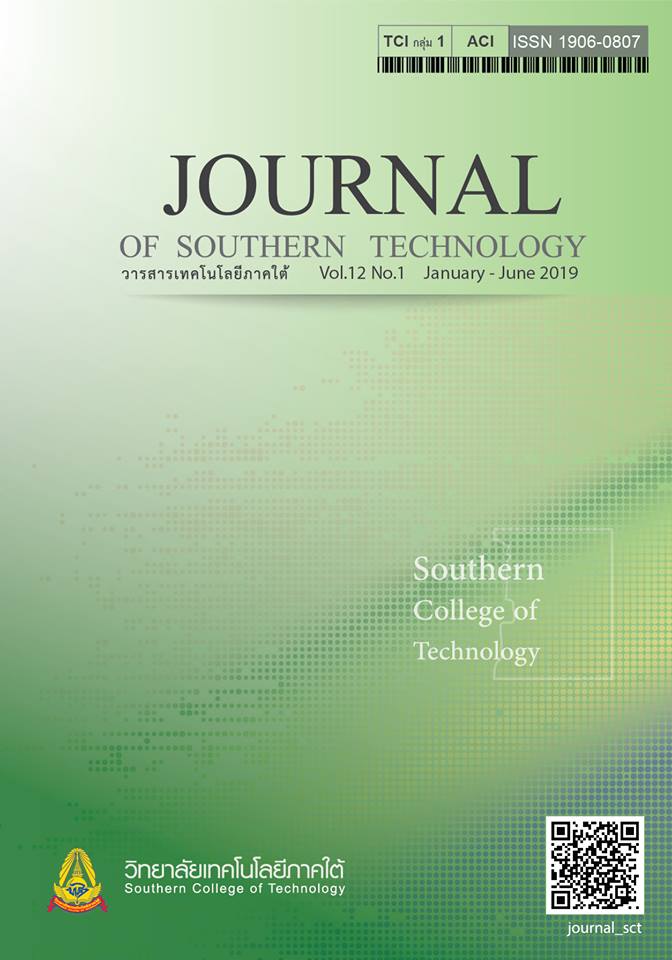Optimum Ratio for Co-producing Plant Pot from Organic Residues
Main Article Content
Abstract
This research examined an optimum ratio for co-producing plant pot from organic residues. Raw materials were used to produce plant pot are local materials: coffee ground, lime from shell and rubber wood sawdust. The objectives aimed to investigate the physical and chemical properties of raw materials, the optimum ratio of raw material and binder for plant pot forming. The ratio of coffee ground:lime from shell:sawdust of 3:0:0 3:0:0 0:3:0 0:0:3 1.5:1.5:0 1.5:0:1.5 0:1.5:1.5 and 1:1:1. Researchers used pasty glue as binder. Each experiment was formed with ratio of raw material:binder of 1:0.70 1:0.85 1:1 1:1.15 1:1.30 1:1.45 1:1.60 1:1.75 และ 1:1.60. Researchers were formed plant pot with automatic potting presses using potting pressure range of 1,600-1,800 psi. The results indicated that raw materials include essential nutrients for plant and organic matter (OM) and. So, they can be used as raw materials in the production of plant pot. The result of plant pot forming shown that the ratio of coffee ground:lime from shell:sawdust of 1.5:1.5:0 can be formed better than another ratio. It formed in range of raw material:binder 1:0.70 to 1:1.75. The production of plant pot from organic residues is the alternative that added value to residues and produced the environmentally friendly product.
Article Details
-
Authors must agree to the journal publication rules and allow the editors to edit the manuscripts for publication.
-
Author’s right belongs to the author but Journal of Southern Technology holds the right of first publication and thus allow readers to use the article for the purpose of education but not commercial.
References
20-21 October 2011 Ambassador City Jomtien, Chonburi. [in Thai]
Chulaka, P., Kaewsorn, P., & Jeenprasom, P. (2014). Effect of Growing Media Containing Coffee Ground on Germination
and Growth of Tomato Seedling (Lycopersicon esculentum Mill.). Agricultural Sci. J., 45(2)(Suppl.), 349-352.
[in Thai]
Kraipittayakorn, W., & Sawain, A. (2016). Feasibility for Producing Biodegradable Pots from Coffee Ground mixed with
Lime from Shell. 15th National Environmental Conference, 11-13 May 2016. The Twin Tower Hotel. Bangkok.
[in Thai]
Phokha, S., Duangaupama, K., & Ruangsan, K. (2011). Plant Pot Production from the Leaves of Sugarcane. Procedia
Engineering, 8, 135-137.
Salange, I. M., Livia, M. C., João, P.A. Silva, Inês, C. R., & José, A.T. (2011). A study on chemical constituents and
sugars extraction from spent coffee grounds. Carbohydrate Polymer, 83, 368-374.
Sawain, A. (2014). Wastewater & Solid Waste Management [Mimeographed]. Department of Environment, Faculty of
Science and Fisheries Technology, Rajamangala University of Technology Srivijaya Trang Campus. [in Thai]
Sopunna, K., Pasorn, W., Woradong, K., & Chaiwangrach, A. (2015). Fabracation and properties of biological plant
pots. SNRU Journal of Science and Technology, 7(2), 1-7. [in Thai]
